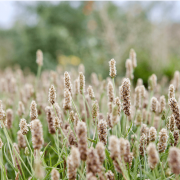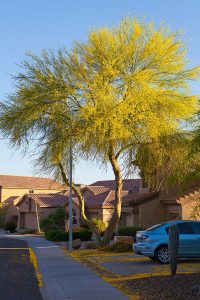Plantago ovata
Plantago ovata is a weed native to the southwestern United States. It’s seeds have been used for food by native populations in Arizona and is a common source of psyillium – a dietary fiber found in products such as Metamucil.
Following a wet winter, Plantago ovata can be found growing wild in the desert and along road sides in the spring. It’s presence contributes signifcantly to South Mountain Park in Phoenix turning green in the spring.

Plantago ovata is related to English Plantain (plantago lanciolata) an important allergenic weed found in Europe, Asia and North America.






 Palo Verde is one of the most common trees of the Sonoran Desert and is found throughout southern Arizona and southeastern California. Starting in April, the Palo Verde produces a brite yellow flower that stands in contrast to it’s characteristic green trunk and branches. In late spring it is common to see the Palo Verde covered in yellow blossoms with a blanket of yellow at it’s base from dropped flowers. It is this fact that makes the Palo Verde a bit of an allergy enigma.
Palo Verde is one of the most common trees of the Sonoran Desert and is found throughout southern Arizona and southeastern California. Starting in April, the Palo Verde produces a brite yellow flower that stands in contrast to it’s characteristic green trunk and branches. In late spring it is common to see the Palo Verde covered in yellow blossoms with a blanket of yellow at it’s base from dropped flowers. It is this fact that makes the Palo Verde a bit of an allergy enigma.




 The olive tree is native to the Mediterranean, Asia, and Africa and has been cultivated for it’s fruit for thousands of years. It is a hardy, drought and disease resistant tree, well suited for the harsh conditions of the Sonoran desert. It is an evergreen tree which can grow to 30 ft and has an attractive gray, often gnarled and twisted trunk gaining character with age. Some trees are hundreds of years old. The olive tree produces a small, inconspicuous pale, white flower which is wind pollinated and produces volumes of airborne pollen in the spring. Olive tree pollen is one of the most potent and sensitizing of the allergenic plants of Arizona. Because of it’s association with severe springtime allergy symptoms, the city’s of Phoenix and Tucson have banned the planting of fruiting Olive trees since the 1960s.
The olive tree is native to the Mediterranean, Asia, and Africa and has been cultivated for it’s fruit for thousands of years. It is a hardy, drought and disease resistant tree, well suited for the harsh conditions of the Sonoran desert. It is an evergreen tree which can grow to 30 ft and has an attractive gray, often gnarled and twisted trunk gaining character with age. Some trees are hundreds of years old. The olive tree produces a small, inconspicuous pale, white flower which is wind pollinated and produces volumes of airborne pollen in the spring. Olive tree pollen is one of the most potent and sensitizing of the allergenic plants of Arizona. Because of it’s association with severe springtime allergy symptoms, the city’s of Phoenix and Tucson have banned the planting of fruiting Olive trees since the 1960s. 



